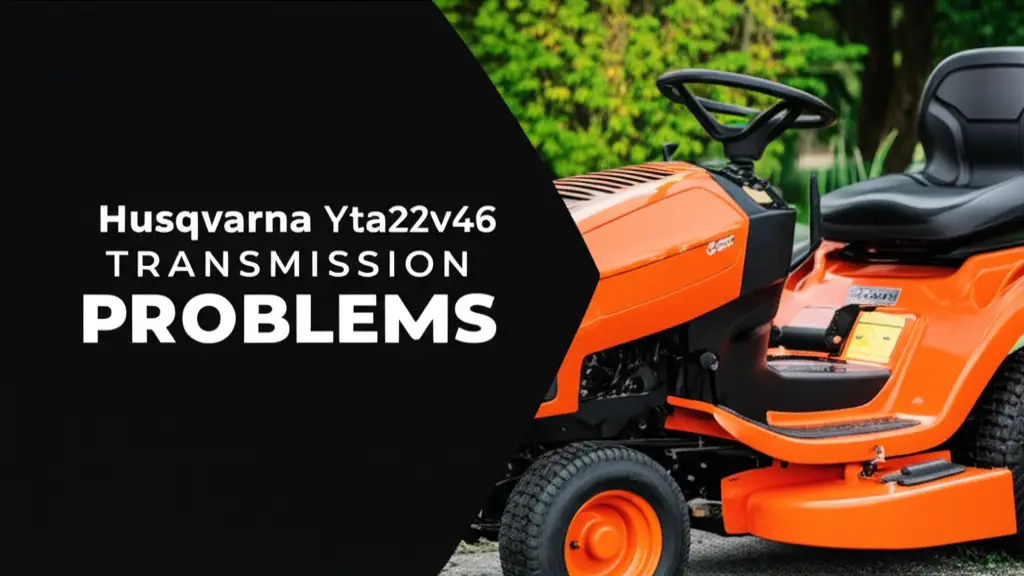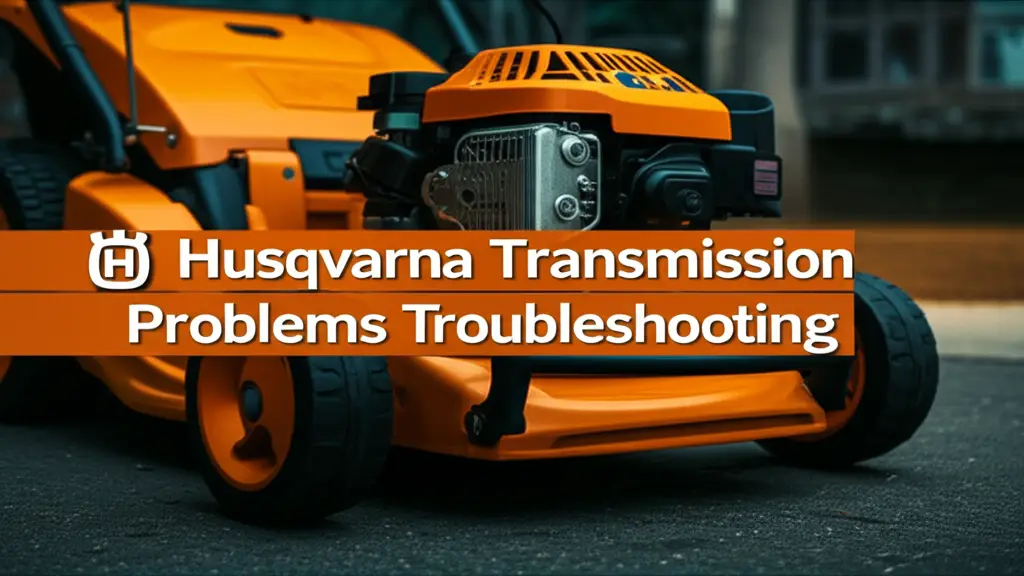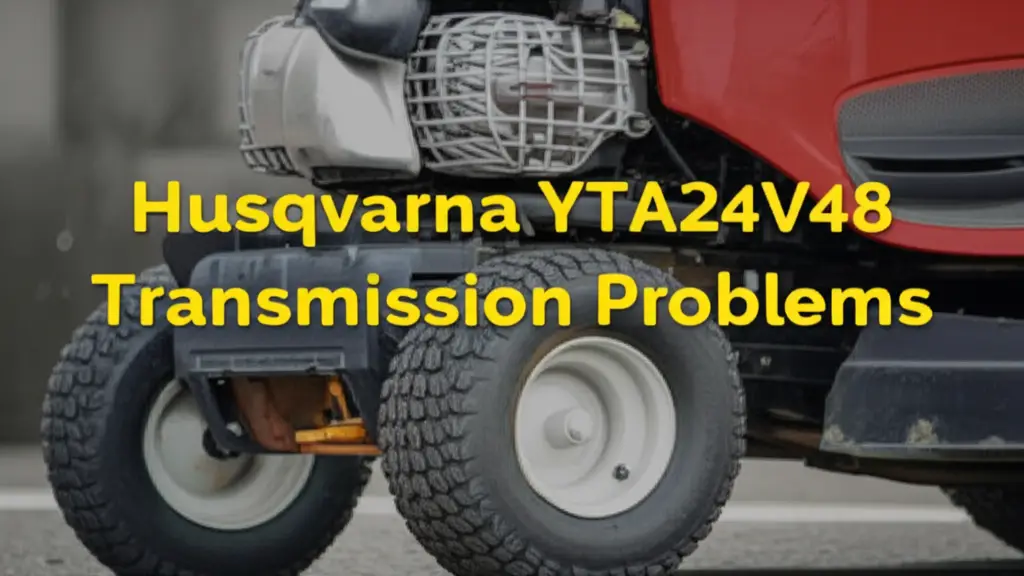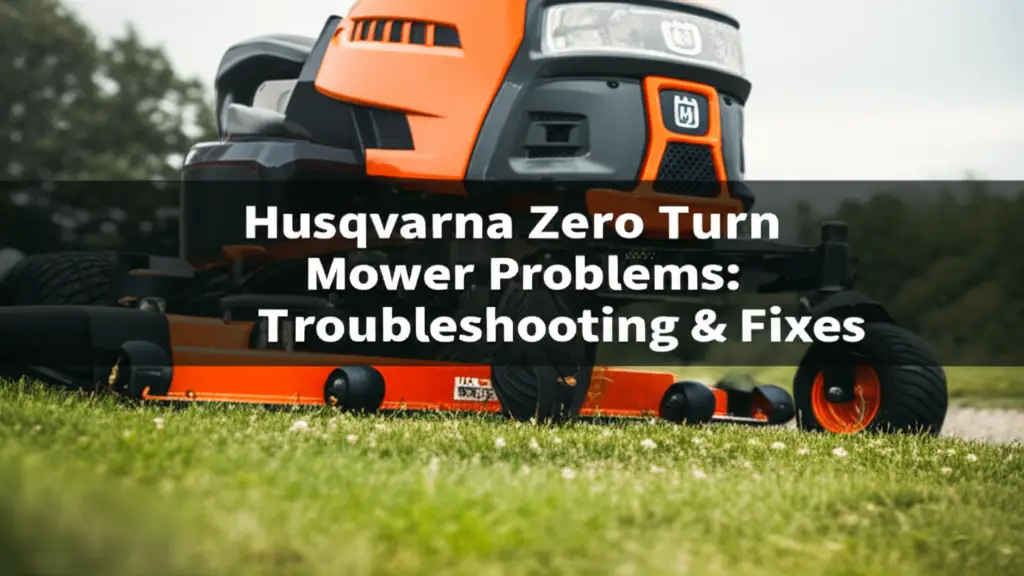· Troubleshooting · 18 min read
Husqvarna Yta22v46 Transmission Problems

Husqvarna YTA22V46 Transmission Problems: A Comprehensive Guide
Is your Husqvarna YTA22V46 losing power, making strange noises, or refusing to move? Transmission problems are a common headache for owners of this popular riding mower. This article will walk you through the most frequent issues, how to diagnose them, and what you can do to get your mower back in working order.
We’ll cover everything from simple fixes to more complex repairs, ensuring you have the knowledge to tackle the problem head-on. Let’s dive into understanding and resolving these frustrating transmission issues.
Takeaway:
- Regularly check your transmission fluid level.
- Avoid sudden stops and starts to reduce strain.
- Consider professional servicing for complex repairs.
- Proper maintenance can significantly extend transmission life.
Transmission Problems: Symptoms, Causes, and Solutions
Recognizing the early signs of transmission trouble can save significant time and expense. Owners of the Husqvarna YTA22V46 should be vigilant for the following common symptoms:
Problem: Loss of Drive or Inconsistent Movement (Forward/Reverse)
Description:
The mower might slow down unexpectedly, move erratically, or cease movement entirely even while the engine continues to run.
This can manifest as a sensation of the mower dragging on flat ground or struggling to maintain a consistent speed.
Causes:
Debris Buildup:
Accumulations of grass clippings, mud, or leaves can significantly impede the mower’s operation.
This debris can gather around the drive wheels or transmission components, reducing traction or physically jamming moving parts, which directly leads to a loss of drive.
A common, yet often overlooked, culprit is debris lodged underneath the brake stop, which can prevent the drive belt from achieving proper tension, resulting in slipping and inconsistent movement.
Drive Belt Issues:
A worn, loose, or improperly installed drive belt is a very frequent cause of drive loss or inconsistent movement.
If the belt lacks sufficient tension, the transmission will not fully engage, leading to noticeable slipping.
Clutch Cable and Linkage Issues:
A loose or broken clutch cable or drive cable can prevent the transmission from fully engaging, leading to a loss of drive.
Over time, the entire drive control system can gradually become “loose,” resulting in decreased speed or responsiveness.
Low Transmission Fluid/Air in System:
Low fluid levels or air trapped within the hydraulic system (cavitation) can severely impair performance, leading to a loss of power or sluggishness.
Solutions:
Clean Debris:
Thoroughly clean out any trash or grass cuttings from the drive wheel area, including the dust cover, pinion, and drive wheel gear teeth.
For the brake pedal area, engage the parking brake and meticulously remove any compacted clumps of clippings that might be obstructing its full range of motion.
Inspect and Adjust Drive Belt:
Conduct a careful visual inspection of the drive belt for any signs of cracks, fraying, or excessive slack.
Ensure that the belt is correctly routed around all pulleys according to the manufacturer’s diagram. A properly tensioned belt should feel taut and firm to the touch.
Inspect and Adjust Clutch Cable and Linkages:
Check the tension of the clutch wire and drive belt. Inspect the drive cable for any signs of looseness or breakage.
Look for a turnbuckle, often located on the underside of the drive control housing, which can be adjusted to increase cable tension.
Ensure that all linkages are operating smoothly, without excessive play in pivot points or any debris obstructing their full range of movement.
Purge Air from System: To remove trapped air from the General Transmission Fast CVT (RT400) system, follow these steps:
- Preparation: Park the mower on a level surface, ensure the engine is off, and engage the parking brake. For safety, elevate the rear wheels securely using jack stands.
2. Disengage Transmission: Locate the freewheel control, typically found at the back of the mower’s frame, and place it in the freewheeling or disengaged position.
3. Start Engine & Adjust Throttle: Sit in the operator’s seat, start the engine, and move the throttle control to the slow position.
4. Neutral & Brake: Position the motion control levers in neutral (N) and slowly disengage the clutch/brake pedal.
5. Cycle Motion Control: Push the motion control levers fully forward and hold them in that position for five seconds. Then, pull them to the full reverse position and hold for five seconds. Repeat this forward-reverse cycle a total of three times. It is normal for the drive wheels to exhibit some slight movement during this procedure, as air is being expelled from the hydraulic drive system.
6. Return to Neutral & Shut Off: After completing the cycles, move the motion control levers back to the neutral (N) position, shut off the engine, and set the parking brake.
7. Re-engage Transmission: Return the freewheel control to its engaged position.
8. Final Drive Cycle: Restart the engine, setting the throttle control to half speed. Slowly disengage the clutch/brake pedal. Gradually move the motion control lever forward, allowing the tractor to roll approximately five feet. Then, slowly move the lever to the reverse position and drive backward for about five feet. Return the motion control lever to neutral. Repeat this entire sequence three times.
9. Check Fluid: For models equipped with an external oil reservoir, check the fluid level after purging and add oil as necessary to meet specifications.
Problem: Slowing Down, Especially on Inclines or When Hot
Description:
A frequently reported issue is the mower losing power or coming to a complete stop when attempting to ascend hills, or after prolonged operation when the transmission has heated up.
Causes:
Overheating:
Overheating is a primary factor in the degradation and premature failure of CVT transmissions.
Common causes include heavy or prolonged use, towing beyond capacity, frequent stop-and-go operation, and inadequate cooling.
Degraded Transmission Fluid:
When the transmission overheats, the fluid loses its critical lubricating properties, leading to accelerated wear on internal components. This degradation is intensified by heat and stress.
Overloading:
Operating the mower beyond its specified capacity or excessive towing places immense stress on the transmission.
Solutions:
Clean Cooling Fins:
Regularly clean the pump cooling fins with a rag, brush, or compressed air to ensure optimal heat dissipation.
It is also vital to ensure that the transmission air intake is clear of any grass clippings, dirt, or other debris.
Avoid Overloading:
To prevent overheating, avoid overloading the mower beyond its specified capacity and refrain from excessive towing, as CVTs are generally less tolerant of heavy loads than other transmission types.
Consider Fluid Change:
While often described as “sealed,” the fluid in CVTs degrades over time. Proactive fluid changes, even if challenging, can substantially extend the operational life of these units.
Problem: Unusual Noises (Whining, Grinding, Rattling)
Description:
While some CVTs naturally produce a slight whine, any new or excessive noises such as grinding, rattling, or a loud humming can signal internal wear, including stretched belts or failing bearings.
A grinding sound, in particular, often suggests metal-on-metal contact within the unit.
Causes:
Worn Pulleys:
The metal belt and the surfaces of the pulleys within a CVT system are subject to constant friction and wear.
This wear can affect the effective diameter of the pulleys, compromising power transfer.
Failing Bearings:
Worn-out bearings can produce grinding and whining noises.
Internal Wear:
General Transmission CVTs experience internal wear primarily within their pulley systems.
Low/Contaminated Fluid:
Inadequate or degraded fluid can lead to increased friction and noise.
Solutions:
Inspect Pulleys:
Visually inspect all pulleys for signs of wear, damage, or excessive play. Replace any pulleys that show significant wear or damage.
If applicable, ensure that idler pulleys are properly lubricated.
Check Fluid Condition: Inspect the transmission fluid for proper level and signs of contamination.
Internal Inspection (Professional Recommended):
If external checks and fluid maintenance do not resolve the problem, internal inspection may become necessary.
This typically involves removing and disassembling the transmission, a task that is often complex and best undertaken by those with considerable mechanical experience.
Problem: Delayed Response or Complete Failure to Move
Description:
The operator might notice a hesitation when attempting to engage drive or reverse, or the mower may simply refuse to budge at all.
Causes:
Internal Wear:
Wear within the transmission’s internal components can lead to a loss of power or complete immobility.
Fluid-Related Problems:
Low fluid levels, degraded fluid, or air trapped in the system can cause delayed response or no movement.
Electrical Faults:
Malfunctions within the electronic control system can impact the transmission’s control.
Linkage Problems:
Loose or damaged linkages can prevent proper engagement.
Solutions:
- Perform Purge Procedure: Follow the detailed steps to purge air from the hydraulic system.
- Inspect Fluid: Check the transmission fluid level and condition.
- Check Linkages: Ensure all control linkages are properly connected and adjusted.
- Professional Diagnosis: For complex electrical faults or confirmed internal wear, professional diagnosis with specialized equipment may be required.
Problem: Difficulty Engaging Gears or “Locked” Pedal
Description:
The accelerator pedal might feel as though it is “locked” into the forward position, or it may require excessive force to depress the reverse pedal to engage it.
Causes:
Loose/Damaged Linkages:
Issues with the forward/neutral/reverse lever or its associated linkage can cause operational problems.
Debris around Pedal:
Debris lodged around the pedal or control mechanisms can obstruct their movement.
Incorrect Neutral Settings:
Incorrect neutral settings can lead to issues such as hard shifting.
Issues with Shift Cam, Inversion Kit, or Variation Controls:
General Transmission RT400 troubleshooting guides specifically mention problems with these components as potential causes for a loss of traction or reduced speed range.
Solutions:
- Inspect and Clean Linkages: Inspect and clean linkages, ensuring they operate smoothly without excessive play or obstruction.
- Adjust Linkage Tension: The tension on the drive cable can often be increased by adjusting a turnbuckle.
- Adjust Neutral Position: Adjust the neutral position according to the manufacturer’s instructions.
- Inspect and Replace Internal Control Components: Inspect components like the shift cam, inversion kit, or variation controls for breakage, bending, or obstruction. Replacement kits for these specific components are available.
Problem: Fluid Leaks
Description:
The presence of any red or brown fluid beneath the mower is a clear warning sign of a transmission fluid leak.
Causes:
Damaged Axle Seals:
These leaks often originate from worn or damaged axle seals. They may not always be immediately obvious, as they can be hidden behind the mower’s wheels.
Loose Connections:
Loose connections in the transmission system can also lead to fluid leaks.
Solutions:
- Visually Inspect for Leaks: Regularly check the area behind the rear wheels for any signs of fluid leakage.
- Replace Axle Seals: Replacement axle seals are readily available for these transmissions.
Husqvarna YTA22V46 Transmission Symptoms & Quick Checks
| Symptom | Potential Causes | Quick Check/Action |
|---|---|---|
| Loss of Drive / Inconsistent Movement | Loose/Worn Drive Belt, Debris Buildup, Low Transmission Fluid, Air in System | Inspect belt tension & condition, Clean debris from drive areas, Check fluid level, Perform purge procedure |
| Slowing on Hills / When Hot | Overheating, Degraded Transmission Fluid, Overloading | Clean cooling fins, Check fluid condition, Reduce load |
| Unusual Noises (Whining, Grinding, Rattling) | Worn Pulleys, Failing Bearings, Internal Wear, Low/Contaminated Fluid | Inspect pulleys for wear, Check fluid level & condition, Listen for location of noise |
| Delayed Response / No Movement | Internal Wear, Fluid Issues, Linkage Problems, Electronic Faults | Check linkages, Perform purge procedure, Inspect fluid |
| Difficulty Engaging Gears / “Locked” Pedal | Loose/Damaged Linkages, Debris around Pedal | Inspect and clean linkages, Adjust linkage tension |
| Fluid Leaks | Damaged Axle Seals, Loose Connections | Visually inspect for leaks, Check fluid level, Replace seals if necessary |
DIY Repair vs. Professional Service: Making the Right Call
Deciding whether to attempt a repair yourself or seek professional help often comes down to a balance of complexity, cost, and personal mechanical aptitude.
When to Confidently Tackle Repairs Yourself
Many common transmission issues for the Husqvarna YTA22V46 are well within the capabilities of a mechanically inclined homeowner. Confidently tackling these repairs can save considerable time and money. These include:
- Debris Buildup: Clearing grass clippings, mud, and leaves from around the drive wheels, transmission components, and cooling fins.
- Drive Belt Replacement: Inspecting, tensioning, and replacing a worn or loose drive belt.
- Purging Air: Performing the step-by-step procedure to remove trapped air (cavitation) from the hydraulic system.
- Axle Seal Replacement: Addressing fluid leaks originating from damaged axle seals.
These are often the first and most cost-effective steps in troubleshooting.
When Professional Intervention is Necessary
For more complex or internal issues, professional service is generally recommended. Attempting repairs beyond one’s skill level can lead to further damage and increased costs. Professional intervention is advisable for:
- Internal Mechanical Failures: If symptoms persist after basic troubleshooting, pointing to worn pulleys, internal component wear, or damage within the transmission casing.
- Complex Electronic Control Issues: Problems with the valve body or electronic control unit typically require specialized diagnostic equipment and expertise.
- Transmission Removal and Disassembly: While some users successfully undertake this, disassembling and rebuilding a “sealed” transmission like the General Transmission Fast CVT is highly complex and carries significant risk without specialized tools and in-depth knowledge.
Cost Estimates for Common Repairs and Full Transmission Replacement
Understanding the potential costs can help in making an informed decision.
- DIY Costs (Parts Only):
- Drive belts: Typically range from $12 to $60.
- Axle seals: Can be found for around $10.
- Tuff Torq K46 repair kits (for comparison, as YTA22V46 uses General Transmission): Range from approximately $250 to $500.
- General Transmission repair kits (e.g., variation kit, secondary pulley): Costs vary depending on the specific part, but individual components are available.
- Professional Costs (Parts + Labor):
- General lawn mower repair: Typically ranges from $75 to $550.
- Labor rates: Professional shops usually charge $55 to $135 per hour, though some may charge up to $170 per hour.
- Diagnostic fee: Expect to pay between $35 and $90.
- Transportation fee (if the shop picks up the mower): Ranges from $30 to $100.
- Hydro flush (for hydrostatic transmissions, but relevant for fluid service): Costs typically range from $140 to $320.
- Full transmission replacement: Can range from $625 to $2,500. An OEM replacement transaxle for a similar Husqvarna model (YTH22V46) has been listed around $934 to $1038.
The following tables provide a clear comparison of transmission types and an overview of DIY versus professional repair considerations:
Transmission Fluid Specifications & Maintenance Schedule
| Feature | General Transmission Fast CVT (RT400) (Husqvarna YTA22V46) | Tuff Torq K46 Hydrostatic (Example: Husqvarna YTH22V46) |
|---|---|---|
| Transmission Type | Continuously Variable Transmission (CVT) | Hydrostatic Transmission |
| Fluid Type Recommended | Specialized CVT fluid (consult manual/dealer for exact spec) | Tuff Tech 5W-50 synthetic oil, or 10W-30/J20C |
| Capacity (Approx.) | Not widely published for user refill; often considered “sealed” | 2.2-3 Liters when empty |
| Serviceability/Maintenance | Often described as “sealed,” but fluid changes recommended by users for longevity; typically requires transmission removal for service | ”Not technically serviceable” by manufacturer, but fluid changes recommended after 50 hours (initial) then every 200 hours for heavy use; requires transmission removal |
| Common Issues | Overheating, pulley/belt wear, fluid degradation, axle seal leaks, control issues | Cavitation (air in system), worn cylinder blocks/center case, fluid degradation, drive belt issues, linkage problems |
DIY vs. Professional Repair: Cost & Complexity Overview
| Repair Type | DIY Feasibility | DIY Cost (Parts Only) | Professional Cost (Parts + Labor) | Notes |
|---|---|---|---|---|
| Debris Removal | Easy | $0-$10 | $75-$150 | Requires basic tools and cleaning supplies |
| Belt Replacement | Moderate | $12-$60 | $100-$200 | May require some disassembly; proper tensioning is crucial |
| Purging Air | Moderate | $0 (if no fluid top-off needed) | $140-$320 (often part of larger service) | Requires elevating mower; follow precise steps |
| Fluid Change | Difficult/High Risk | Fluid cost (varies) | $140-$320 (hydro flush equivalent) | Often requires transmission removal and careful refilling; risk of using wrong fluid |
| Internal Component Repair (e.g., pulleys, specific kits) | Difficult/High Risk | Repair kit cost (varies, e.g., $250-$500 for K46) | $300-$1000+ (depending on specific repair) | Requires transmission removal, disassembly, specialized tools, and expertise |
| Full Transmission Replacement | Difficult/High Risk | $175-$1,300 (aftermarket/used) | $625-$2,500 (OEM) | High cost, complex installation, often requires professional alignment/purging |
Preventative Maintenance: Extending Your Transmission’s Life
Proactive maintenance is the most effective way to extend the life of your Husqvarna YTA22V46’s transmission and avoid costly repairs.
Regular Cleaning Practices:
Preventing the accumulation of debris is fundamental.
Regularly clean grass clippings, mud, and leaves from around the drive wheels, transmission components, and especially the cooling fins and air intake.
While a hose can be used for general cleaning, it is important to avoid directing high-pressure washers or steam cleaners at bearings and electrical components, as water ingress can cause corrosion and damage.
Adhering to Fluid Change Intervals (Even for “Sealed” Units):
Despite manufacturers sometimes labeling transmissions as “sealed for life”, the reality is that transmission fluid degrades over time due to heat and operational stress.
This degradation leads to a loss of lubrication and cooling properties, ultimately shortening the transmission’s lifespan. Therefore, regular fluid changes are crucial for CVT longevity.
For Tuff Torq K46 transmissions (a common comparison), a fluid change is recommended after the initial 50 hours of operation, and then every 200 hours thereafter for heavy usage.
While specific intervals for the General Transmission are not as widely detailed for user changes, the principle of proactive fluid maintenance remains vital.
The “sealed for life” narrative, while seemingly convenient, often translates to a hidden cost for the consumer in the form of premature transmission replacement.
This approach, where components are designed to last only for a specific period (e.g., the warranty), rather than for their maximum potential lifespan, encourages a cycle of replacement over repair.
This has broader implications for both consumer finances and environmental impact, as it contributes to increased waste.
Since fluid degradation is an inevitable process, and many “sealed” units are not designed for easy fluid service, their failure is a certainty.
This means that proactive, albeit sometimes challenging, fluid changes can be a significant investment in the mower’s long-term value, directly contradicting the implied “no maintenance needed” stance.
Avoiding Overloading, Excessive Towing, and Prolonged Use on Steep Inclines: These activities place immense stress on the transmission, leading to overheating and accelerated wear.
Continuously Variable Transmissions (CVTs), in particular, generally have lower towing capacities compared to other transmission types.
Operating the mower within its practical limits, rather than pushing it to its advertised maximum capabilities, is crucial for preserving the transmission.
Seasonal Checks and Storage Tips:
Before the first use of the season, especially after winter storage, it is advisable to purge the transmission to remove any trapped air that may have accumulated.
Additionally, always remove the ignition key when the mower is not in use to prevent accidental battery drain or unintended operation.
The combined challenges of inherent overheating in CVTs and the “sealed” nature of some transmissions suggest that manufacturers may design equipment for an average consumer use profile within a warranty period, rather than for a truly extended lifespan or heavy-duty applications.
This implies that for owners who wish their equipment to last well beyond this intended period, a more proactive and often more involved maintenance regimen is necessary, such as performing fluid changes on “sealed” units.
Furthermore, understanding and operating the machine within its true practical limits, not just its maximum advertised capabilities, becomes crucial.
This shifts a greater degree of responsibility and control over the product’s longevity to the informed consumer.
Conclusion: Keep Your Mower Moving Smoothly
Maintaining a Husqvarna YTA22V46 involves understanding its unique General Transmission Fast CVT system.
Recognizing common symptoms such as loss of drive, slowing on inclines, or unusual noises is the first step toward effective troubleshooting.
Many issues can be resolved with straightforward initial checks, including clearing debris, inspecting and tensioning the drive belt, and purging air from the system.
The distinction between the YTA22V46’s General Transmission CVT and other Husqvarna models featuring Tuff Torq hydrostatic transmissions is vital to prevent misdiagnosis and ensure appropriate repairs.
While manufacturers may label these transmissions as “sealed,” proactive fluid maintenance is a critical, albeit sometimes challenging, step for extending the unit’s operational life beyond its typical warranty period.
Overheating, often exacerbated by heavy use or neglected cooling fins, is a primary cause of fluid degradation and premature wear, underscoring the importance of thermal management.
Ultimately, empowering oneself with knowledge about the YTA22V46’s transmission is key to its longevity.
Proactive steps like regular cleaning, operating the mower within its practical limits, and addressing fluid health can significantly reduce downtime, frustration, and repair expenses.
When faced with complex issues or uncertainty, consulting a qualified professional is always a prudent decision to ensure the mower continues to perform reliably for years to come.
Frequently Asked Questions (FAQs)
What type of transmission does the Husqvarna YTA22V46 have?
The Husqvarna YTA22V46 typically features a General Transmission Fast CVT, often specifically the RT400 model. This is a key distinction from the Tuff Torq K46 hydrostatic transmission found in some other Husqvarna models.
Is the Husqvarna YTA22V46 transmission sealed? Can the fluid be changed?
The General Transmission in the YTA22V46 is often described by manufacturers as a “sealed unit”. However, fluid degradation is an inevitable process, and many experienced users and mechanics advocate for fluid changes to extend the transmission’s lifespan, even if it requires removing the transmission from the mower for access.
What kind of oil does the Husqvarna YTA22V46 transmission use?
The General Transmission Fast CVT requires a specialized CVT fluid. Unlike conventional motor oil, this fluid has specific friction properties crucial for the belt-and-pulley system. While specific OEM recommendations for user changes are not widely published, it is always best to consult the owner’s manual or a Husqvarna dealer for the most accurate and current recommendation.
How often should the Husqvarna YTA22V46 transmission be purged?
It is recommended to purge the transmission before its first use, after long periods of storage (typically over two months), or if any symptoms of drive loss or sluggish response are observed.
Why does the Husqvarna YTA22V46 lose power when it gets hot or goes uphill?
This is a common symptom indicative of overheating and fluid degradation within CVT transmissions. When the transmission fluid gets too hot, it loses its essential lubricating properties, leading to reduced power transfer. Regularly cleaning the cooling fins and avoiding overloading the mower can help mitigate these issues.
What is the cost to replace a Husqvarna YTA22V46 transmission?
A full transmission replacement for a riding mower can range significantly, typically from $625 to $2,500. An OEM replacement transaxle for a similar Husqvarna model (YTH22V46) has been listed in the range of $934 to $1038. Repair kits for internal components may be available at lower costs, depending on the specific part needed.
Conclusion
Dealing with Husqvarna YTA22V46 transmission problems can be frustrating, but with a little knowledge and effort, you can often diagnose and fix the issue yourself. Remember to prioritize safety, follow the manufacturer’s recommendations, and don’t hesitate to seek professional help when needed.
Regular maintenance, including checking fluid levels and changing the fluid and filter, is crucial for preventing future problems and keeping your mower running smoothly for years to come. By understanding your transmission and taking proactive steps, you can enjoy a reliable and efficient mowing experience.
- Husqvarna transmission
- YTA22V46 problems
- hydrostatic transmission
- lawn mower repair
- transmission troubleshooting




